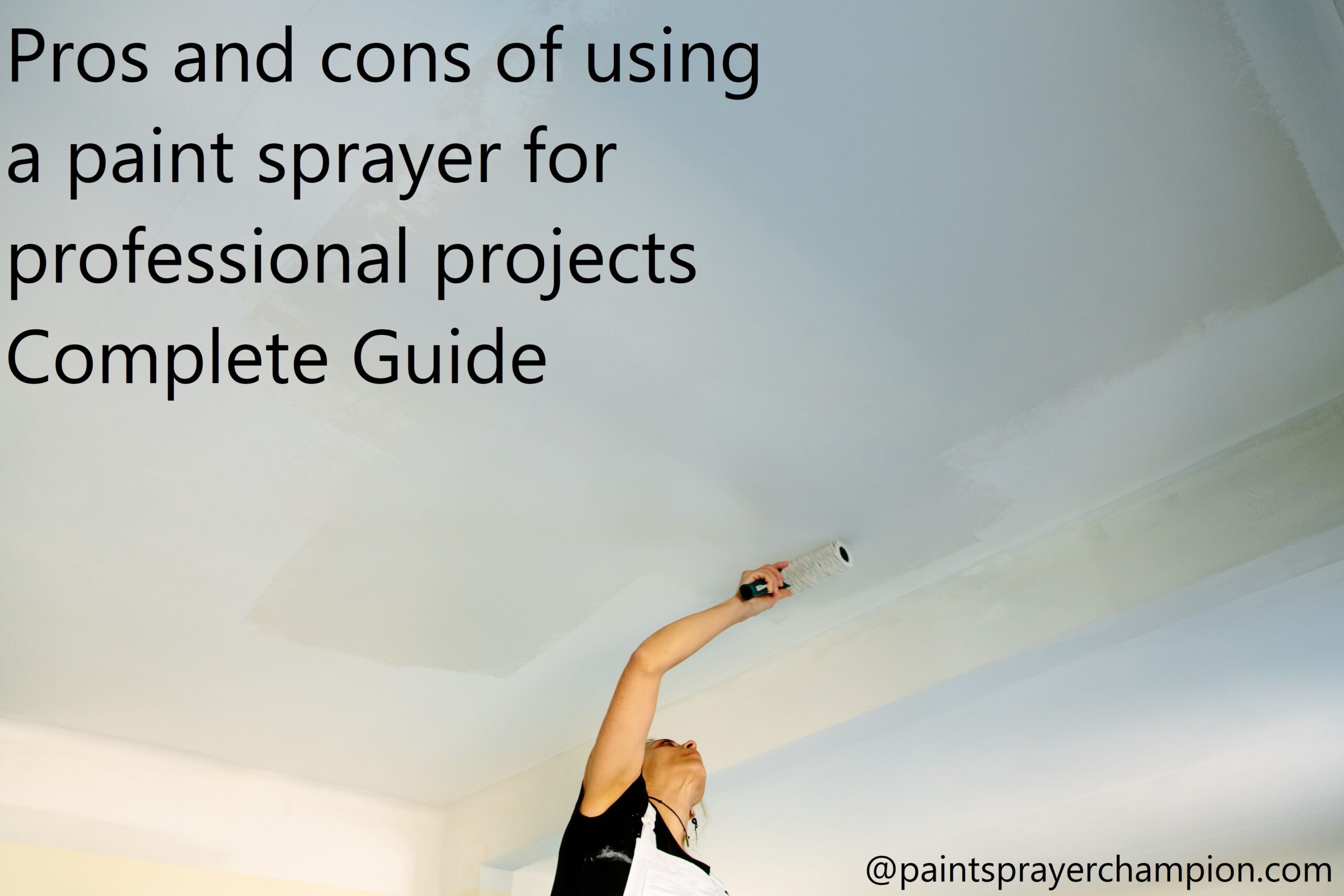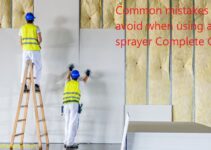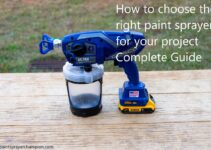Are you considering using a paint sprayer for your next professional project? If so, look no further. Here you’ll find a comprehensive guide to the pros and cons of paint sprayers, helping you make an informed decision.
From understanding the tool’s capability to factors such as cost and health safety, you’ll find all the knowledge needed for an effective professional project.
The use of a paint sprayer to complete professional projects can bring immense benefits, but it is important to understand the pros and cons of this technology. This guide seeks to provide an overview of the fundamentals in regards to paint spraying, beginning with a look at the advantages and disadvantages before exploring the types of sprayers available and providing tips on how to get the best results when working with a paint sprayer.
Understanding what a paint sprayer can offer is key when undertaking any professional project, as making an informed decision will ensure you achieve high-quality results without any unnecessary disruption or risk. For those who are seeking more information on paint sprayers and their use in professional projects, this guide will provide answers to key questions while helping prevent potential paint spraying problems.
Explanation of what a paint sprayer is and how it works
A paint sprayer is a device that uses compressed air to atomize and propel liquid paint onto surfaces. It works by passing the paint particles through a high-velocity nozzle which then atomizes them into a fine mist, allowing for even and consistent coverage with minimal effort. Paint sprayers come in several different types and can be used both professionally and for DIY projects.
The most common type of paint sprayer is an airless sprayer which consists of a pneumatic motor, tip size adjustment, and control knob that allow you to adjust the amount of air pressure used to atomize the paint into a fine mist. This type of sprayer is commonly used in industrial painting projects such as warehouses, factories, and ships or on construction sites where the area being painted needs a large amount of coverage in less time than traditional brush painting would require.
Other types of sprayers are designed for smaller projects such as painting furniture or walls. These include HVLP (high volume, low pressure) models for home use that use smaller amounts of air pressure to atomize the paint particles so they land on the surface evenly with less overspray than other models. These are ideal for smaller DIY projects such as furniture restoration or painting trim around windows doors or baseboards.

Importance of paint sprayers in professional projects
Using a paint sprayer is becoming increasingly popular for professional projects due to its speed, accuracy, and efficiency. These devices allow painters to apply paint quickly and in a uniform manner, resulting in high-quality results. Paint sprayers can be used on a variety of surfaces such as walls, furniture, cabinets, cabinets doors and drawers etc., providing long-lasting results with a professional finish.
Paint sprayers help to reduce time and labor cost associated with traditional painting methods since they require fewer dips with the container every few inches. This results in faster completion of painting projects as well as less mess for clean up. Furthermore, paint sprayers also reduce the risk of potential damage that can result from manual application methods such as brush strokes or roller marks.
Moreover, some high-end professional models come with features such as adjustable air pressure settings that allow the user to decide how much flow is necessary for each task. This allows professionals to control the flow of their material so their paint job does not become too thin or thick which can cause unevenness on the surface being painted. In addition to this feature, some models come with anti-clog mechanisms which are designed keep materials from spreading uncontrollably ensuring that you gain consistent coverage through every surface in your project without wasting time or energy on unnecessary corrections.
Pros of using a paint sprayer for professional projects
Using a paint sprayer for professional projects can have many advantages, ranging from increased efficiency to improved accuracy. Here are some of the benefits that come with using a paint sprayer:
- Fast Job Times: Paint sprayers are faster and more efficient than traditional painting methods, allowing professional contractors to finish jobs in less time. This not only saves them money, but it also speeds up their turnovers and leads to increased customer satisfaction.
- Precision Painting: With a quality paint sprayer, professional painters can apply precise lines and edges with each job. This ensures that the job is done right the first time, leading to fewer touchups and better overall results.
- Cost Savings: Paint sprayers require less paint than traditional rollers or brushes in most cases, which can lead to cost savings for both professionals and customers alike. Additionally, since fewer supplies need to be purchased for each job completed with a paint sprayer, professionals have more resources available for other projects.
- Fewer Brush Marks: Paint brush marks are unsightly on any wall or surface, but they’re unavoidable when using traditional painting methods such as rollers and brushes. With a paint sprayer however, these faint brush strokes are almost never visible in the end result – meaning your customers will appreciate the smooth final look much more!
Faster and more efficient than traditional painting methods
Paint sprayers provide a convenient, efficient, and fast solution to painting any surface. Paint sprayers are designed to work easily with most single-stage and two-stage paints and stains, covering large areas quickly. This makes them an ideal choice for larger projects, especially those that require more than one coat. Paint sprayers also allow for greater control of the application rate as opposed to traditional brushwork, providing an even color across the entire surface.
With a paint sprayer you can get great coverage with fewer coats than you would with a brush or roller, leading to faster project completion times.
Compared to traditional methods of painting like a brush or roller, using a paint sprayer significantly reduces the amount of time that it takes to paint. It is much faster than any other method due to its uniform application and speed in which it covers large surfaces quickly and evenly. Furthermore, because the coverage is much more consistent than with a brush or roller there is less time wasted trying to go back over areas that have been missed or need further attention. The fast-drying qualities of paint sprayed on also helps cut down on time as well as reducing wastage from paint left on brushes or rollers that would have been used if painting by hand was being used instead. Finally the smooth finish provided by a professional grade sprayer allows for less touchup afterwards making sure the job’s finished product looks all the better for it!
Consistent and even coverage
When using a traditional roller or brush, there can be issues with consistent coverage, especially on large projects. A paint sprayer produces even coverage with little chance of streaks or blotches. This makes them especially suitable for more sophisticated home decorating projects, where complete uniformity is desired.
A professional painter will generally achieve better results when compared to manual painting tools as there are fewer areas that end up with lines where plaster and wallpaper have been missed. Additionally, the finish tends to be more continuous and finished-looking than when using manual tools, making it perfect for standard walls as well as surfaces that need more finesse.
Ability to reach difficult and tight spaces
One of the biggest advantages of using a paint sprayer for professional projects is its ability to reach difficult and tight spaces. This means that you won’t have to spend time trying to maneuver a brush or roller in small areas, as the sprayer can cover them quickly and more thoroughly than manual tools.
For example, in cases where a complex surface has uneven parts that require extra care, the spray gun can be easily re-positioned to cover all these surfaces with minimal effort. Even when using a spray gun outdoors, it can be easily used on small balcony corners or between stairs without causing too much of a mess. Additionally, you will be able to save time while painting small sections due to the efficient and smooth finish provided by the sprayer.

Can be used on a variety of surfaces and materials
A paint sprayer is an incredibly versatile tool that can be used on a variety of surfaces and materials. They can be used to paint walls and furniture, as well as other materials such as metal and wood. The ability to spray a thin but even layer of paint helps reduce potential errors made while hand-brushing, which in turn reduces time spent waiting for additional coats or touch-ups. Since the sprayer allows for faster coverage with more even results, many professionals find it to be the best choice when painting large projects.
The versatile nature of paint sprayers also makes them ideal for more intricate projects, such as painting cabinets or furniture pieces with detailed moldings. The thin but even layers created by the nozzle allow you to maintain control over where the paint goes without having to brush it into crevices. The same is true for uneven surfaces such as cedar shake siding – by using a high-pressure stream instead of brush strokes, you can reach areas where you would otherwise not be able to apply the paint evenly.
Paint sprayers are portable devices that only require minimal setup before they are ready to use, making them ideal for most any situation. Whether you’re working on indoors or outdoors, a residential project or commercial one – there’s sure to be a paint sprayer that fits your needs perfectly!
Can save money in the long run
Using a paint sprayer for professional projects can bring with it many advantages, such as saving time and creating professional-looking surfaces. Although they can be an expensive initial investment, they can actually save money in the long run if used wisely and properly maintained. As well as reducing labor costs, these devices also save time since much less effort is required when painting than when using brushes or rollers. Paint sprayers can also extend the lifetime of a surface, leading to reduced maintenance costs in the future.
Another benefit of using paint sprayers for professional projects is that not only do they create a finely atomized layer of paint which gives consistent coverage and smooth finishes to walls, they are also more efficient with paint use than traditional methods of painting. This benefit is especially valuable when bigger projects and more extensive coatings are involved as up to four times more coverage per litre compared to other methods is achievable with the right equipment. However, it is important to understand that there will be wastage due to overspray and this has to be accounted for before starting the job.
In conclusion, if used properly, a paint sprayer has the potential to save money in terms of labor costs, time and paint consumption in the long run; however careful consideration must be given on balancing these versus the cost of investment and materials wastage due to overspray.
Cons of using a paint sprayer for professional projects
Although paint sprayers can be incredibly useful tools when it comes to professional painting projects, they also come with a few drawbacks that should be taken into consideration.
The primary drawback is the amount of overspray produced. Overspray is the excess paint that is produced outside of the intended area being painted. This excess paint can create a mess, contaminate surfaces, and result in wasted materials and time due to clean up and repair work needed as a result of overspray.
In addition, there is also the potential for hazardous materials exposure if paints and thinners are misused during a paint project. Protective gear must be worn at all times when around or using these materials to avoid exposure to dangerous fumes and chemicals.
Lastly, there can also be an increased cost associated with having larger and more powerful paint spraying equipment required for certain jobs, which may mean having to purchase specialized equipment or renting it on an as needed basis.
Requires more preparation and cleanup than traditional painting methods
Using a paint sprayer can be a great way to apply paint to professional projects. However, when compared to traditional methods, such as hand-brushing or rolling, it does require more preparation and cleanup. This includes:
– Covering nearby surfaces with plastic drop cloths so that the overspray from the paint sprayer does not cause damage or mess.
– Taking measures to ensure clean air and ventilation such as running fans in the area or wearing masks and protective clothing.
– Washing down the walls and surfaces to be painted before beginning in order to remove any debris or dust that may affect the finish.
– Following safety protocols when handling and storing paints, solvents and other chemicals used during spraying operations.
– Cleaning equipment thoroughly after each use, including any hoses or attachments used in conjunction with the unit.
– Hiring certified professionals who have experience with using paint sprayers safely and effectively in order to achieve high quality results on your projects.
May require additional equipment, such as a compressor or spray booth
Under ideal circumstances, paint sprayers should come with a large array of accessories which can greatly increase their efficiency and capabilities for an experienced user. However, these accessories are usually not required for professional painting jobs. High-end paint sprayers may also require additional equipment in order to achieve satisfactory results, such as a compressor or even a full spray booth.
Compressors provide the additional air pressure needed to fully atomize the paint particles when using a paint sprayer at higher levels of power. On the other hand, spray booths provide space and fans that help keep mist away from work surfaces while providing users with better control over their painting environment.
Despite these added components being optional for most projects, having them may be necessary for specific jobs that involve high-viscosity paints or large areas needing to be covered quickly. In these cases, having a compressor and/or spray booth on hand can make paint spraying much more effective and efficient while producing beautiful results.
:max_bytes(150000):strip_icc()/is-a-paint-sprayer-necessary-1822685-hero-c1a7269b8be14eceb076d9d0c38a97f0.jpg)
Conclusion
The decision to use a paint sprayer for professional projects should be based on the particular job. If the project has detailed, intricate parts, a brush or roller may be the best option since a paint sprayer may result in overspray. If the job consists of larger or exterior surfaces, a paint sprayer may be ideal and lead to better results in less time.
It is crucial to consider all factors when deciding whether or not to use a paint sprayer for any given painting project. Taking into account preparation time, robot and distance from other areas is essential when making this decision. It is also important to understand what consequences can arise if these considerations are not taken into account when using a paint sprayer so that proper safety procedures can be followed and quality results can be achieved at all times.
FAQ’S
What are the disadvantages of using a paint sprayer?
Some disadvantages of using a paint sprayer include the potential for overspray, difficulty controlling the amount of paint applied, and the need to clean and maintain the equipment properly.
Do professional painters use spray guns?
Yes, many professional painters use spray guns as part of their toolkit.
What are the pros of a paint sprayer?
Some advantages of using a paint sprayer include faster application, smoother and more even coverage, and the ability to reach difficult areas more easily.
Is using a paint sprayer worth it?
It depends on the project and the user’s preferences. A paint sprayer can be a worthwhile investment for those who frequently tackle large painting projects, but it may not be necessary for smaller jobs.
What are the problems with paint spraying?
Some problems with paint spraying include the need for proper ventilation, potential for overspray, and the need to carefully mask surrounding areas to avoid unintentional paint application.
What are the advantages and disadvantages of using power sprayer?
Advantages of a power sprayer include faster application and more even coverage. Disadvantages include the need for proper ventilation and the potential for overspray.
Is spraying better than painting?
It depends on the project and the user’s preferences. Spraying can be faster and more efficient for large projects, while painting with a brush or roller may be better for smaller, more detailed work.
Which is better roller or sprayer?
It depends on the project and the user’s preferences. Rollers may be better for smaller, more detailed work, while sprayers can be faster and more efficient for larger projects.
Do professional painters spray or roll?
Professional painters may use both spray guns and rollers, depending on the project and the desired outcome.
What is a disadvantage of painting with a spray gun rather than a paint brush?
One disadvantage of using a spray gun is the potential for overspray, which can result in unintentional paint application on surrounding surfaces.
See Also:
- Best hvlp paint sprayer
- Best paint sprayer for cabinets
- Best cordless paint sprayer
- Best paint sprayer attachment for air compressor
- Best airless paint sprayer


